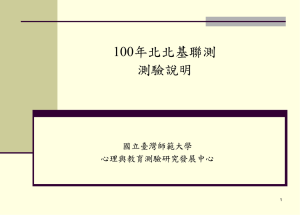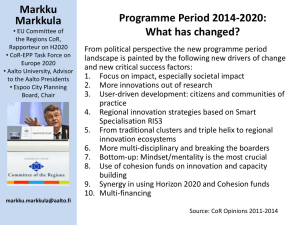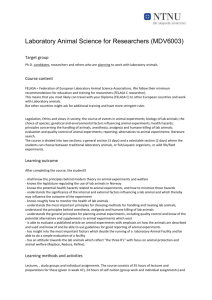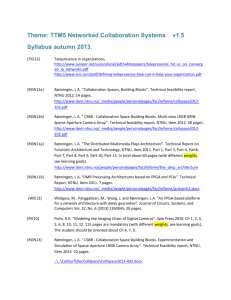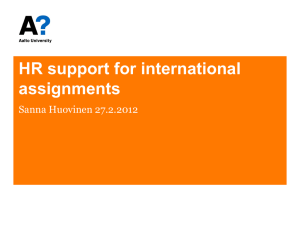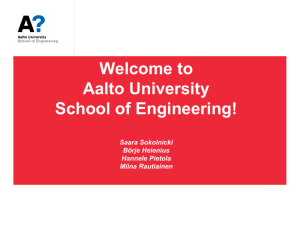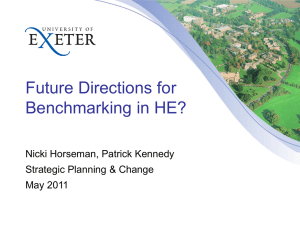Presentation
advertisement
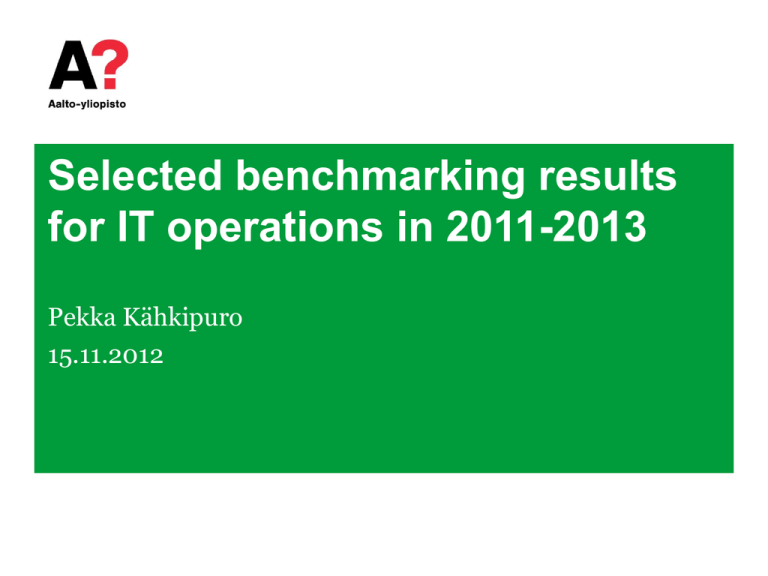
Selected benchmarking results for IT operations in 2011-2013 Pekka Kähkipuro 15.11.2012 Benefits of benchmarking • IT performance booster – Gain understanding through comparison with peer institutions – Understand your relative position amongst the competition – Learn more about your own IT environment • Tool for University strategy execution – Is our institution really executing its strategy, giving the knowledge on what the others are doing • Why is the European context needed – Higher Education is a global business – national benchmarking does not provide enough information – The best comparison partners (i.e. a universities with a similar profile) may be difficult to find from your own country – EDUCAUSE focuses on US style HE institutions and metrics – Commercial services are expensive and limited in many ways Aalto IT costs and personnel in 2011 Costs Centralized IT costs IT costs in other central units IT costs in academic units Total IT costs IT share of university costs Personnel Centralized IT personnel IT personnel in other central units IT personnel in academic units Total IT personnel IT share of university personnel 2010 M€ 12,3 2,0 5,0 19,3 2010 2011 M€ 67 % 16,5 6% 0,8 27 % 9,7 100 % 27,7 5,1 % 2010 FTE 150 9 68 227 4,8 % 2011 59,4 2,9 35,1 100 % % % % 6,8 % 2010 2011 FTE 146 66 % 11 4% 56 30 % 213 2011 65,1 % 4,9 % 25,1 % 100 % 4,3 % IT technology volumes in 2011 Logical Servers 2011 X86 Linux By OS X86 Windows Other (Unix, etc.) By org In centralized IT In distributed IT Physical servers total In centralized IT Workstations Total Windows By OS Linux MacOS and other By type 1768 1235 436 97 70 % 25 % 5% 610 35 % 1158 65 % 932 100 % 240 26 % 2010 2011 9 837 11884 7 296 8619 1 977 1308 564 2185 Desktops 8 091 7330 Laptops and other 1 746 4554 6 921 2 308 608 7887 2078 449 By known Personal use use Classroom Laboratory use Data centers Centralized Distributed Total 2010 2011 Major 2 9 20 11 2011 2011 Minor Area 2 300 m2 21 500 m2 23 804 m2 Common storage Storage in centralized IT Storage in distributed IT Total 2010 Tb 2011 Tb 800 900 220 1180 1020 2080 Network / phones / other Active LAN ports Number parallel WLAN users Network/multifunction printers Service desk tickets annually 2010 2011 15 480 16700 1 841 3150 939 1353 25756 33788 Note: central IT is fully visible, distributed is probably not, so the real figure might be even higher IT Spending as % of OPEX Universities with technical inclination share a common pattern Ratio: IT / Institution (%) 7.0 % 6.0 % 5.0 % 4.0 % IT share of institution budget € IT share of institution personnel FTE 3.0 % 2.0 % 1.0 % 0.0 % AY HY TUT UiO NTNU AY = Aalto University HY = Helsinki University TUT = Tampere University of Technology UiO = University of Oslo NTNU = Norwegian University of Science and Technology Application development increase expected: renewal projects are about to start End-User support divided to schools and faculties Share of IT costs within organization Different organizational approaches, but distributed IT is present in most cases *Ratio: IT-costs (%) 100% 90% 80% 70% 60% Unspecified IT costs in academic units 50% IT costs in other central units 40% Centralized IT costs 30% 20% 10% 0% AY HY TUT UiO NTNU AY = Aalto University HY = Helsinki University TUT = Tampere University of Technology UiO = University of Oslo NTNU = Norwegian University of Science and Technology Security support Run cost is high, education average is also (too) high Incident management • Aalto’s process is not able to track all incidents Tickets/person Ticktets/Staff FTE 700 20.0 18.0 600 16.0 500 14.0 400 12.0 10.0 300 8.0 6.0 200 4.0 100 2.0 0 0.0 AY HY NTNU UTA UTU AY HY NTNU UTA UTU Selected findings and related actions Initiatives to improve performance • 34 data centers • Data center consolidation initiative • High number of workstations and high FTE in support • More collaboration with schools to reduce overlapping work • Increase workstation support efficiency (automation, process) • Increase in storage requirements • Initiative to support increasing needs in the academic community. • Increase in mobility • Initiatives to make mobile services and increase mobility. • Oversized end-user services • Initiative to increase incident management efficiency Summary • Benefits for the IT organization – Identify performance improvement needs – Finding the right distribution of resources for services – Source of new ideas: • What have others done • What could be done differently • Benefits for the institution – Is the institution directing its resources correctly (IT vs. other options) – Are there ways to increase competitiveness through IT • Findings – Comparison with a handful of peers is not enough to get the full picture – Time and effort is needed to understand results and to realize the benefits – The process itself is already very useful Additional slides A bit more on the started actions High number of workstations and high FTE in support • Personnel moving towards ”PC + laptop” model – Is this really what Aalto wants? • Spend distribution and costs at schools indicate overlapping work – Better division of work and harmonization of work practices – Additional measures to be taken later • Justification for the 2nd round in the migration project (and even the 3rd round) 34 data centers • 2011: We discovered 20 data centers • 2012: We discovered 34 data centers • Conclusions – New data center concept (2013) – Data center consolidation project (2014 onwards) – Communicated to the school level Increase in storage requirements • Knowledge through BM and stakeholder meetings. • Storage program initiated in 2013. – Focus on supporting research storage requirements. • Different needs and different solutions – – – – Fast storage Cloud storage Cheap storage Secure storage Mobility increase • Big increase in mobile devices – Changing fixed lines into mobile phones • 75% of new phones are smartphones – Mobile platform support (m.aalto.fi) • Network renewal program – Changing network architecture to support the increased need – New network architecture (4 IP addresses per person) Incident management efficiency • Need to increase incident management efficiency – Project to improve incident management efficiency and tools. • Need to build a common model with our schools – Common process – Common tools – Transparency across organization boundaries
